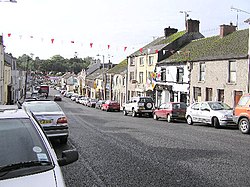Ballygawley, Tyrone
| Ballygawley | |
| Tyrone | |
|---|---|
 Ballgawley | |
| Location | |
| Grid reference: | H630574 |
| Location: | 54°27’42"N, 7°1’41"W |
| Data | |
| Population: | 711 (2011) |
| Post town: | Dungannon |
| Postcode: | BT71 |
| Dialling code: | 028 |
| Local Government | |
| Council: | Mid-Ulster |
| Parliamentary constituency: |
Fermanagh and South Tyrone |
Ballygawley or Ballygawly is a village and townland in Tyrone, about twelve miles south-west of Dungannon, near the meeting of the A5 Londonderry–Dublin and A4 Dungannon–Enniskillen roads.
The name of the village is from the Gaelic Baile Uí Dhálaigh, meaning 'Ó Dálaigh's town'.[1][2] It is in the Barony of Clogher, along the River Blackwater.
Contents
Geography
An American visitor in 1925 commented on the way the village was laid out: "...Ballygawley, which I found to be a village or settlement on two streets (or possibly on one street which turned at right angles to my left as I stood looking at the buildings when I came in sight of the place). It was a wide street, with excellent cement sidewalks not very wide, and the buildings came up flush with the sidewalks, and there were no alleys, driveways or paths between the buildings."[3]
It is a compact village around the ‘L’ shaped Main Street and Church Street, formerly Meeting House Street, with a second cluster of development to the southwest. The main cluster inholds most of the village's facilities; two primary schools, churches and a range of shops and services. The cluster of development to the southwest inholds a secondary school and housing. Ballygawley had a population of 642 at the =2001 Census.
History
Ballygawley is also known as "Errigal-Kerogue" or "Errigal-Kieran", supposedly from the dedication of an ancient church to St. Kieran (Ciarán of Clonmacnoise). Some of the remains of the old church were known, and an ancient Franciscan friary, founded by Conn O'Neill, 1st Earl of Tyrone. In the churchyard was a large stone cross, and a holy well.[4]
Ballygawley railway station (on the narrow gauge Clogher Valley Railway) opened on 2 May 1887 but was shut on 1 January 1942.[5]
Development
Ballygawley is acquiring extensive development with the major upgrade to the A4 and the building of the new roundabout to accommodate the traffic congestion from the main Aughnacloy road. These road improvements many contractors have been submitting plans for extensive housing developments. The most exciting of all being the redevelopment of Main st leading onto Church Street, with plans for new bars and restaurants. There is speculation of the Stewart Arms hotel being reopened and other developments such as the health spa at 'Grangemount'. There are other developments such as the rebuilding of Loughrans Castle as a historical building to house historical items from the surrounding area. The Ballygawley River is a major tourist attraction supplying the finest of fresh water fishing in Ireland. The original hydro-electric station at the old Dungannon road is being rebuilt to provide a large amount of the town's energy.
Events
Although having an Irish nationalist majority, Ballygawley is paraded through by the unionist loyal orders without any incident and last held the Orange Orders "Twelfth" celebrations in 2018,[6] and the Royal Black Institutions "Black Saturday" demonstration in 2011.
Outdoor activity centre Todds Leap is located in Ballygawley hosting various events and outdoor activities.
Sport
- Gaelic sports: Errigal Ciarán GAC
About the village
The townland contains one Scheduled Historic Monument: a castle (H63245749).[7]
| ("Wikimedia Commons" has material about Ballygawley, Tyrone) |
References
- ↑ Ballygawley - Placenames NI
- ↑ Mills, Anthony David: 'A Dictionary of British Place-Names' (Oxford University Press, 2003) ISBN 978-0-19-852758-9
- ↑ Hadden, John Alexander. 1956. Alexander Hadden: a short biography. Cleveland: Gates Legal Pub. Co. Pages 2-3. OCLC: 3375165.
- ↑ Errigal Keerogue. 1837. A Topographical Dictionary of Ireland. Page 609.
- ↑ "Ballygawley station". Railscot - Irish Railways. p. 6. http://www.railscot.co.uk/Ireland/Irish_railways.pdf#page=6.
- ↑ "Ballygawley: intimate Twelfth gets World Cup fever" (in en). 2018-07-12. https://www.newsletter.co.uk/news/ballygawley-intimate-twelfth-gets-world-cup-fever-1014008.
- ↑ "Scheduled Historic Monuments (to 15 October 2012)". NI Environment Agency. http://www.doeni.gov.uk/niea/the_schedule_of_historic_monuments_-_october_2012-2.pdf.
Books
- Errigal Keerogue. 1837. A Topographical Dictionary of Ireland.
- Harris, Mary N.. 2004. MacRory, Joseph. Oxford: Oxford University Press. MacRory, Joseph (bap. 1861, d. 1945), cardinal, was born in Ballygawley, co. Tyrone, where he was baptized on 10 March 1861, one of ten children of Francis MacRory (d. 1867?), a small farmer, and Rose Montague.
- Ingram, Brett:
- 'The Armavigil. Ballygawley': Produced for the Irish Church Independence Centenary pageant (1970)
- 'The Ulstertide. Ireland: s.n. Ulster (Ireland) -- Emigration and immigration' (1960)
- Kirkland, Richard: 'Ballygawley, Ballylynn, Belfast: Writing about Modernity and Settlement in Northern Ireland': The Irish Review, 2009 (40/41): 18–32
- Latimer, W. T.: 'Interesting Find at Ballygawley' (1900) The Journal of the Royal Society of Antiquaries of Ireland 10 (4): 368
